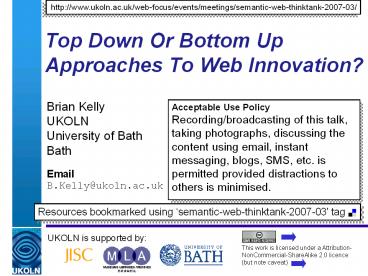Top Down Or Bottom Up Approaches To Web Innovation? - PowerPoint PPT Presentation
Title:
Top Down Or Bottom Up Approaches To Web Innovation?
Description:
http://www.ukoln.ac.uk/web-focus/events/meetings/semantic-web-thinktank-200 7-03 ... Semantic Web vs. l/c semantic web debates flourish; W3C revive HTML developments ... – PowerPoint PPT presentation
Number of Views:190
Avg rating:3.0/5.0
Title: Top Down Or Bottom Up Approaches To Web Innovation?
1
Top Down Or Bottom Up Approaches To Web
Innovation?
http//www.ukoln.ac.uk/web-focus/events/meetings/s
emantic-web-thinktank-2007-03/
- Brian Kelly
- UKOLN
- University of Bath
- Bath
Acceptable Use Policy Recording/broadcasting of
this talk, taking photographs, discussing the
content using email, instant messaging, blogs,
SMS, etc. is permitted provided distractions to
others is minimised.
Email B.Kelly_at_ukoln.ac.uk
Resources bookmarked using semantic-web-thinktank
-2007-03' tag
UKOLN is supported by
This work is licensed under a Attribution-NonComme
rcial-ShareAlike 2.0 licence (but note caveat)
2
Traditional Approaches
- What we thought
- W3C was the trusted guardian of Web innovations
- W3C saved us from fragmentation threats
- W3C would continue to roll out innovations which
would be deployed in the market place - W3C standards would form the basis for digital
library development programmes (e.g. NOF-digi
JISC programmes etc.)
3
Were We Right?
- NOF-digi JISC Standards documents
- Use PNG SVG SMIL
- Flash, PDF, Java, arent open so they dont fit
in with an open standards approach - Web Services Semantic Web standards will be
important - What happened
- PNG SVG SMIL?
- Flash PDF Java widely deployed, so a more
flexible approach for use of standards was
adopted - Web Services Considered Harmful panel at WWW 2005
- Amazon report REST approach preferred to W-S
standards (80/20) - Semantic Web vs. l/c semantic web debates
flourish - W3C revive HTML developments
An evidence-based approach begins to be
preferred to ideological beliefs
4
Role of Web 2.0
- Web 2.0
- Forget (for now) blogs, wikis, etc.
- Consider characteristics such as rapid
development, user engagement, always beta,
clean URIs, microformats, mashups, - Suggestion
- Web 2.0 clearly provides (today) the rich
environment for developing popular
user-focussed services - We should be looking (outwards) at the successes
of the Web 2.0 environment and not (inwards) at
new schema developments
5
Light- vs. Heavy-Weight Development
- Lightweight Exploitation
- Companies with limited funding (6 months to
release or we dont get paid) - This helps to avoid mission drift, feature creep
a user-focus (it must be cool we must
exploit viral marketing) - Heavyweight Exploitation
- (Typically) public-sector bodies in large
consortia - Worthy but most definitely not cool
- Focus groups advisory bodies and need to address
multiple political cultural pressures stifle
innovation - Academic organisations cause drift towards
addressing intellectually challenging problems - Inability to respond quickly to technological
cultural changes
A Daily Mail stereotype of public sector IT
development, or a valid criticism of national
/international development activities?
6
Exploiting Web 2.0 Developments
Yahoo! Pipes is RSS Feed Mashup Editor
- What can we do?
- Explore Yahoo Pipes as a lightweight development
tool
7
Are Museums Doing It Right?
- Reflections on Nick Pooles vision
- NP We should place a 2-year moratorium on new
projects, programmes and initiatives focus
public funds instead on sustained investment in
core capacity building and skills development
NP Significant investment should be made in 3-4
high-value, high-density destination sites such
as the 24 Hour Museum which act as 'ambassadors'
for our sector in the online environment
BK Small-scale investment should be made in 3-4
low-cost, high-density mashup sites such as the
24 Hour Museum alongside encouragement to 3rd
party 'ambassadors' for our sector (e.g. YouTube).
8
In Harmony With The BBC
- BBC 2.0 vision outlined at JISC Conference (13
March) - Do not attempt to do everything yourselves link
to other high-quality sites yourselves (cf use of
Flickr as repository selection process for John
Peel day photos) - Fall forward fast make many small bets
- Treat the entire web as a creative canvas (i.e.
blended stuff) - The web is a conversation join in. Adopt a
relaxed conversational tone. Admit your mistakes.
(i.e. dont tell) - Maximise routes to content. Develop as many
aggregations as possible reflecting as many
people, places topics, channels, networks and
time as possible. - Let people paste your content on the walls of
their virtual homes. YouTube is an excellent
example of this. - Link to discussions on the web, dont host them
Only host web-based discussions where there is a
clear rationale. (i.e. exploit 3rd party
services)
9
Why Not?
Why Not?
JISC
Were reliant on large funds from the EU
We have to own the data, the metadata, the
software
JISC
This Web 2.0 thing is simple to use and can
provide lots of benefits!
This doesnt fit our research agenda
Google might go bankrupt
Adapted from Washington Post cartoon
10
Issues
- Some issues for discussion
- Would a heavyweight Semantic Web recommendation
be appropriate at present? - Is a recommendation for a top-down approach
appropriate in a Web 2.0 environment? - Can we regard Web 2.0 as a testbed rather than a
solution? - If a user-focussed approach is advisable, do we
have concrete evidence that a heavyweight
solution (a) is needed and (b) will be used? - What lessons can be learnt from previous cultural
heritage development activities?
In reality well probably have both bottom-up and
top-down approaches. A challenge will be

